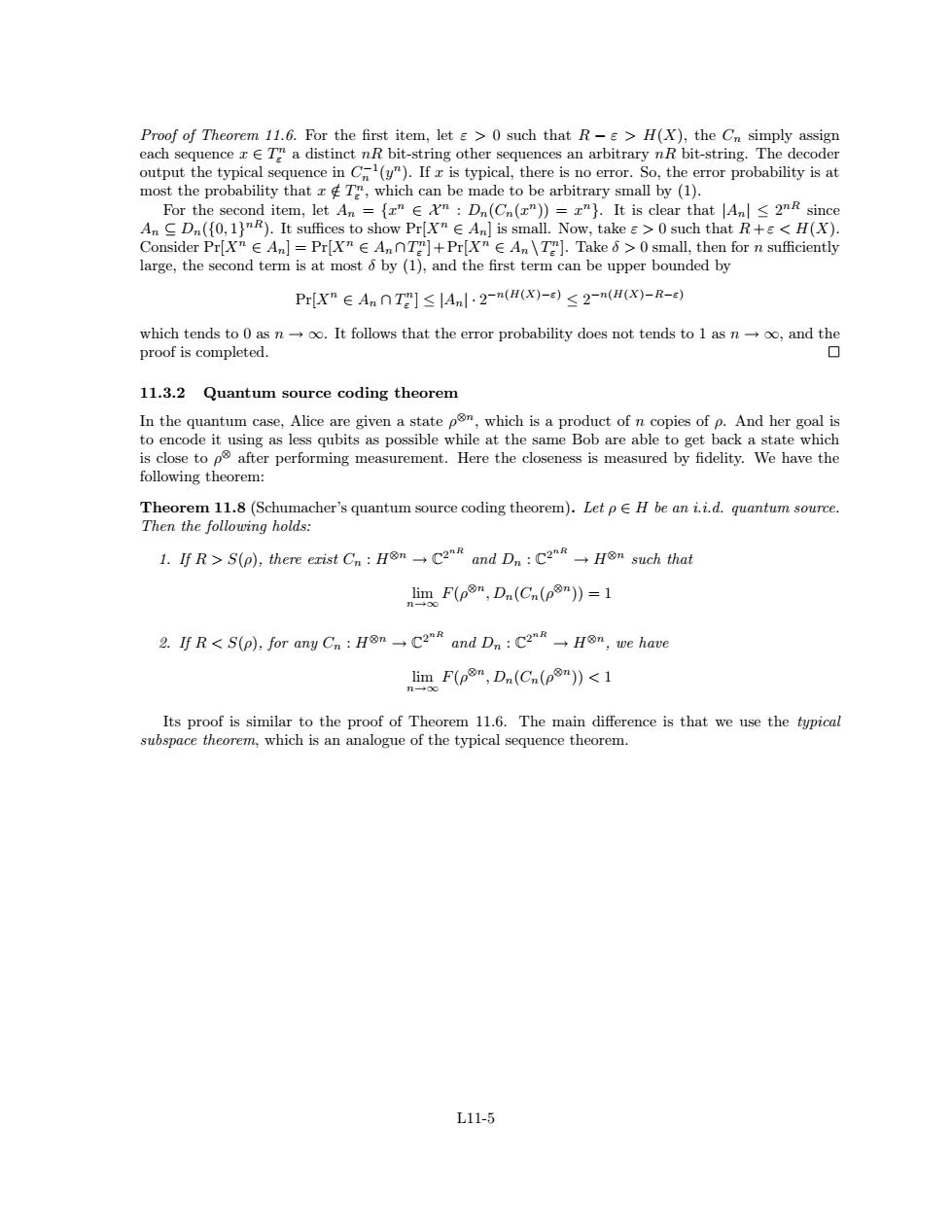正在加载图片...

Proof of Theorem 11.6.For the first item,let s>0 such that R->H(X),the Cn simply assign each sequence r E T a distinct nR bit-string other sequences an arbitrary nR bit-string.The decoder output the typical sequence in C(y").If r is typical,there is no error.So,the error probability is at most the probability that xTr,which can be made to be arbitrary small by (1). For the second item,let An ={rmE tn:Dn(Cn(r"))=r"}.It is clear that Anl 2nR since An C Dn({0,1)nR).It suffices to show Pr[x"E An]is small.Now,take>0 such that R+<H(X). Consider Pr[XT E An]=Pr[Xn E AnnT]+Pr[XnE An\T].Take 6 >0 small,then for n sufficiently large,the second term is at most 6 by (1),and the first term can be upper bounded by Pr[X"∈AnnT]≤lAnl.2-nHX-e)≤2-n(H(X-R-e) which tends to 0 as n-oo.It follows that the error probability does not tends to 1 as n-oo,and the proof is completed. ▣ 11.3.2 Quantum source coding theorem In the quantum case,Alice are given a state p,which is a product of n copies of p.And her goal is to encode it using as less qubits as possible while at the same Bob are able to get back a state which is close to p after performing measurement.Here the closeness is measured by fidelity.We have the following theorem: Theorem 11.8(Schumacher's quantum source coding theorem).Let pE H be an i.i.d.quantum source. Then the following holds: 1.If R>S(p),there erist Cn:HnC2R and Dn C2RH n such that im F(p".Dn(Cn(p))=1 2.If R<S(p),for any Cn:HnC2R and Dn C2RH n,we have lim F(pn,Dn(Cn(pn))<1 n40 Its proof is similar to the proof of Theorem 11.6.The main difference is that we use the typical subspace theorem,which is an analogue of the typical sequence theorem. L11-5Proof of Theorem 11.6. For the first item, let ε > 0 such that R − ε > H(X), the Cn simply assign each sequence x ∈ T n ε a distinct nR bit-string other sequences an arbitrary nR bit-string. The decoder output the typical sequence in C −1 n (y n). If x is typical, there is no error. So, the error probability is at most the probability that x /∈ T n ε , which can be made to be arbitrary small by (1). For the second item, let An = {x n ∈ X n : Dn(Cn(x n)) = x n}. It is clear that |An| ≤ 2 nR since An ⊆ Dn({0, 1} nR). It suffices to show Pr[Xn ∈ An] is small. Now, take ε > 0 such that R + ε < H(X). Consider Pr[Xn ∈ An] = Pr[Xn ∈ An ∩T n ε ]+Pr[Xn ∈ An \T n ε ]. Take δ > 0 small, then for n sufficiently large, the second term is at most δ by (1), and the first term can be upper bounded by Pr[Xn ∈ An ∩ T n ε ] ≤ |An| · 2 −n(H(X)−ε) ≤ 2 −n(H(X)−R−ε) which tends to 0 as n → ∞. It follows that the error probability does not tends to 1 as n → ∞, and the proof is completed. 11.3.2 Quantum source coding theorem In the quantum case, Alice are given a state ρ ⊗n, which is a product of n copies of ρ. And her goal is to encode it using as less qubits as possible while at the same Bob are able to get back a state which is close to ρ ⊗ after performing measurement. Here the closeness is measured by fidelity. We have the following theorem: Theorem 11.8 (Schumacher’s quantum source coding theorem). Let ρ ∈ H be an i.i.d. quantum source. Then the following holds: 1. If R > S(ρ), there exist Cn : H⊗n → C 2 nR and Dn : C 2 nR → H⊗n such that limn→∞ F(ρ ⊗n , Dn(Cn(ρ ⊗n )) = 1 2. If R < S(ρ), for any Cn : H⊗n → C 2 nR and Dn : C 2 nR → H⊗n, we have limn→∞ F(ρ ⊗n , Dn(Cn(ρ ⊗n )) < 1 Its proof is similar to the proof of Theorem 11.6. The main difference is that we use the typical subspace theorem, which is an analogue of the typical sequence theorem. L11-5